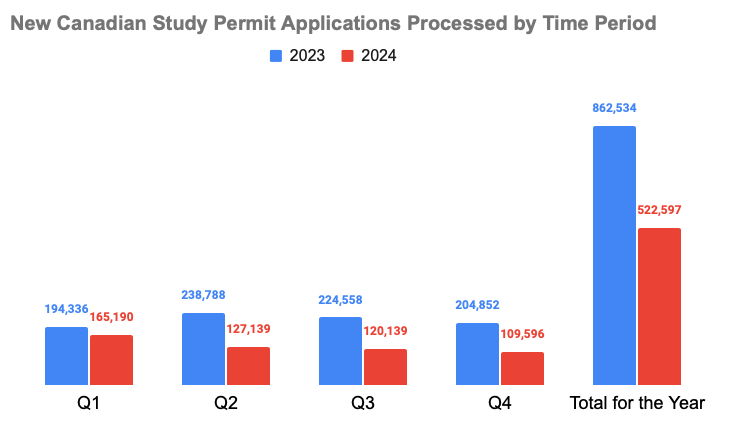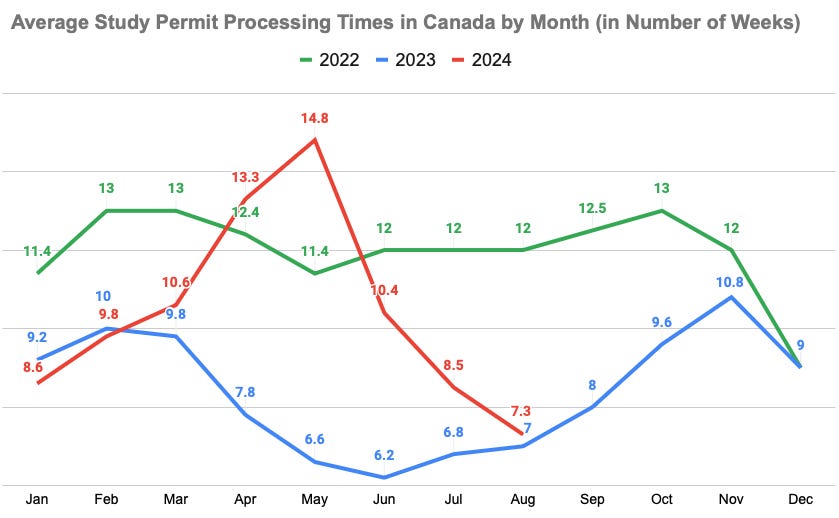4 Things to Expect for Canada's International Student Program in 2025
Here's the rundown of what we can expect this coming year when it comes to international students.
2024 was a rough year for Canada’s international students.
I remember — not so long ago — being a part of the successful advocacy push to position international students as the federal government’s secret weapon to tackling labour shortages.
And it worked. The feds introduced groundbreaking pro-immigration policies, like the temporary pause on off-campus work hours (shown below).
But 2024 marked a sudden turn towards an anti-immigration approach — driven by public rhetoric, media discourse, and opposition parties looking to use the issue to criticize the government.
The federal government (feeling pressure on all sides) decided to make a series of drastic changes.
Last year alone, we saw (and this is not a full list):
35% cut in international students for the next 2 years (2025, 2026)
Additional 10% cut to international students numbers, which also included Master’s and PhD students
Introduction of the mandatory Provincial Attestation Letter (PAL)
Doubling the proof-of-funds limit for applicants (from $10k to $20,635)
Elimination of Student-Direct Streams for in-demand countries, including Nigeria, India, and China.
That was 2024. But what can we expect in 2025?
1) Serious Drop in Study Permit Applications
The first half of 2024 saw a sharp drop in study permits processed, initially from the 35% cut but then also influenced by fewer international students applying for study permits (note that Q1 and Q2 used actuals, while Q3 and Q4 projected numbers were used).
Overall, roughly 39% fewer new study permits were processed in 2024 compared to 2023.
This is even more concerning looking at the first half of the year (Jan-June 2024). Just under 114,000 new study permits were approved, nearly half the number approved in 2023. That’s a drop of 48%!
All in all, this puts us at study permit levels — by the end of 2024 — on par with 2018-19 levels. That’s a staggering shock to the system, particularly given that international students represent roughly 1 in 4 university students and 1 in 3 college students in Canada.
2) Study Permit Processing Times Will Reach Record Speeds
Like I mentioned earlier, the International Student Program was hit with a number of jarring changes, including a doubled proof-of-income level, as well as a new requirement for new applicants to secure a Provincial Attestation Letter (from their province of intended study).
Due to many of these sudden changes, average processing times for Canadian study permits fluctuated wildly in 2024, compared with recent years (note that values for Sept-Dec 2024 were not available at the time of writing).
However, the positive news is that processing times are on track to reach their lowest levels since June 2023. Given the lower volume of applications coming through, we can reasonably expect 2025 study permit wait times to hit record lows (ie very good news for new applicants).
3) Shift in Student Population Demographics
The announcement of restrictive policies — including shutting down Express Study Permit streams (eg Student Direct Stream) and increasing the proof-of-funds limit — will have a profound effect on international student demographics.
A bit of important context first — For the past decade, Canada has increasingly sought out certain countries to recruit immigrants (including international students), namely China, India, Philippines, Nigeria, and others.
It was such a hit that in 2018, the federal government actually created express pathways just for applicants from these countries (ie Student Direct Stream and Nigeria Student Express) in an effort to boost numbers. And it worked!
As you can see below, this has helped shift the international student demographic dynamics in Canada. For example, right now, roughly half of all international students in Canada are from China or India.
Just as we saw how diplomatic incidents with China and India (our two biggest sources of successful international student applicants) led to a marked drop in international student applicants in 2023, we can expect new policy changes promise to radically shift these demographics.
The increased cost of applications — coupled with new policies matching government priorities (eg French language ability) — will likely narrow student demographics to favour (1) families with higher incomes, and (2) francophone applicants.
(Note — if you’re interested in learning more about this topic, check out my deep dive here.)
4) Tough Times Lie Ahead for Us All… Especially Colleges
The federal government’s new restrictive policy changes from 2024 have been resoundingly condemned by the post-secondary sector, none more-so than public colleges.
In its statement on the 2nd round of cuts, Colleges and Institutes Canada stated that “measures announced today will do significant harm… Ottawa has chosen to implement a counterproductive and one-size-fits-all policy to meeting the country’s labour market needs”.
And it’s no wonder why.
More than half of Ontario’s colleges (13 out of 24) will see cuts to their study permit numbers, and it’s wreaking havoc already on their bottom line.
Seneca Polytechnic announced last October it’s closing a campus, Mohawk College is projecting a $50 million deficit for 2025-26, and overall, Ontario colleges have cut their spending by $752 million this year.
According to Alex Usher, we’re in for “a very, very unpleasant few years”.
Looking to the Future
It’s not all doom-and-gloom though.
I’ll follow up with a new entry on how students, institutions, and the sector-as-a-whole can adjust to these new realities. Stay tuned!













